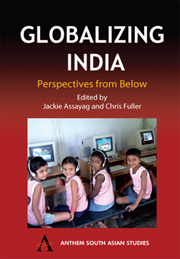Book contents
- Frontmatter
- Contents
- List of Contributors
- Acknowledgements
- 1 Introduction
- Part One Economy and Agriculture
- 2 On the History of Globalization and India: Concepts, Measures and Debates
- 3 In Search of ‘Basmatisthan’: Agro-nationalism and Globalization
- 4 Seeds of Wrath: Agriculture, Biotechnology and Globalization
- 5 Weaving for IKEA in South India: Subcontracting, Labour Markets and Gender Relations in a Global Value Chain
- Part Two Education and Language
- Part Three Culture and Religion
- Bibliography
4 - Seeds of Wrath: Agriculture, Biotechnology and Globalization
from Part One - Economy and Agriculture
Published online by Cambridge University Press: 05 March 2012
- Frontmatter
- Contents
- List of Contributors
- Acknowledgements
- 1 Introduction
- Part One Economy and Agriculture
- 2 On the History of Globalization and India: Concepts, Measures and Debates
- 3 In Search of ‘Basmatisthan’: Agro-nationalism and Globalization
- 4 Seeds of Wrath: Agriculture, Biotechnology and Globalization
- 5 Weaving for IKEA in South India: Subcontracting, Labour Markets and Gender Relations in a Global Value Chain
- Part Two Education and Language
- Part Three Culture and Religion
- Bibliography
Summary
‘If the charkha was the symbol of the Indian Independence, the seed is the symbol for protection of this independence.’
M. D. Nanjundaswamy, President of the Karnataka Rajya Raitha Sangha, 29 December 1993South India
Siddeshvara village in Bidar district, Karnataka, contained about 600 households and 4,000 inhabitants in 1997. Its cramped houses, made of a mixture of straw, stones and mortar, are linked by narrow lanes which are filled with water, rubbish, excrement and cow dung during the monsoon. The Siddeshvara temple overlooks the houses. A new statue recently installed by the members of the dominant caste of Virashaiva-Lingayats marks the entrance to the village. The climate is dry, there is little or no irrigation, harvests are disappointing, the local government is inefficient, and the state apparatus appears to be indifferent.
Shivaraj Mainalle lived in Siddeshvara. He was some 40 years old and the father of five children, the youngest of whom was in the primary school in the fifth standard. He owned 1.28 hectares of land and farmed 3.6 hectares as a tenant (lavani). In 1995– 97, he lost all his harvests because of parasitical worms and the vagaries of the weather. His debt to the local cooperative bank had risen to 24,000 rupees at the end of 1997 and he owed 80,000 rupees to a private moneylender in the village. The purchase of pesticides alone cost him more than 20,000 rupees. Notwithstanding this period of distress, his moneylender demanded his due.
- Type
- Chapter
- Information
- Globalizing IndiaPerspectives from Below, pp. 65 - 88Publisher: Anthem PressPrint publication year: 2005
- 8
- Cited by

